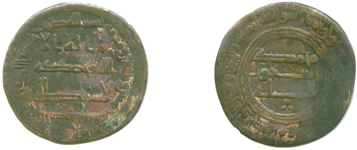His taste is for those little silver dimes, but Mutt also likes an old unidentified piece too. Looking at the coin through a 16 power glass, he recognized the kufic inscriptions, as around 200 AH / AD 813 or almost 1200 years old.
After purchasing the coin from Gene, Mutt showed it to Jeff (1) and asked him to take it with him, scan it and send the picture to Mutt via e-mail. The image was posted on the internet on news groups and eventually on the Islamic Coin Group (I.C.G.) where it was added to their Photo site as no. 40.

It is one of those not quite contemporary forgeries of a al-Kufa 135 A.H. dirhams produced in the second half of the 3rd century A.H., as were found in a North-Western Iranian hoard of forged dirhams around 1970 and published by A.H. Morton in The Numismatic Chronicle 1975, p. 156, no. 5. (2)
Having been a member of the American Numismatic Society for over 30 years, Mutt has been able to acquire all of their annual publications for his numismatic library. He found the reference and read a most interesting article - An Iranian Hoard of Forged Dirhams. The hoard appeared on the Tehran market in 1971. Over a thousand coins found together in a pot. The author A.H. Morton examined nearly four hundred of them. He identified this coin as a forgery from the lot estimated to be dated about AH 260/AD 873-4. The coin is a base metal, copper, which was originally covered by thin silver plating. "Originally they must have been quite convincing", he states.
The coin is a forgery of the mint Al-Kufa, dated AH135/AD 648. Noted as very common. The three references sited do not list the three dots shown on the reverse of this coin or as shown on No.5 Plate 12 in the 1975 Numismatic Chronicle.
Another article examined coins from the Iranian Hoard for metallography and found the coins were counterfeit cast of impure copper and lightly silvered over, so as to be acceptable as dirhams.
Although of little value, this coin picked up at the local coin club meeting has a very interesting history. If it could only talk, it could tell the story of how it was minted as a forgery, buried in Iraq to escape the authorities for over thousand years. Part of the hoard found was transported to Iran to be sold in the local bazaar. From there it traveled to the States, was acquired by a coin collector and disposed of, as part of a collection to a Florida dealer as unidentified. Then researched on the World Wide Web, identified by numismatist fluent in Arabic, compared to the writings of another knowledgeable numismatist, identified by similar pieces in the collection of the American Numismatic Society (3) and now the subject of this story.
(1) Thanks to Jeff for editiorial collaboration.
(2) Thanks to the I.C.G. members who assisted with the identification.
(3) Thanks to the Curator of Islamic Coins for additional identification.